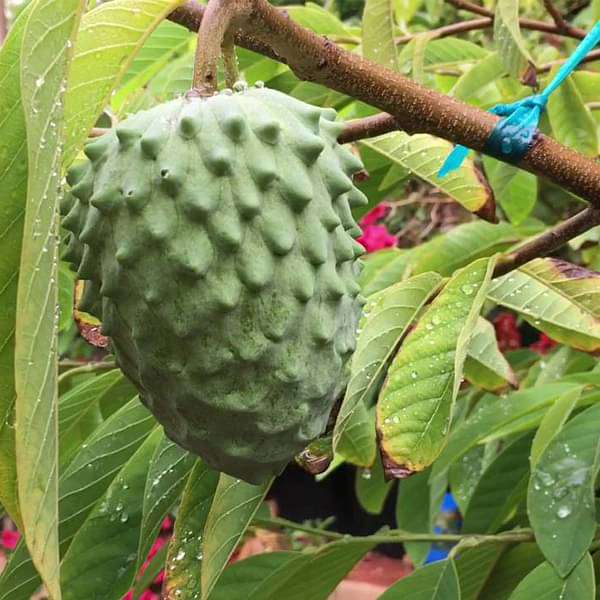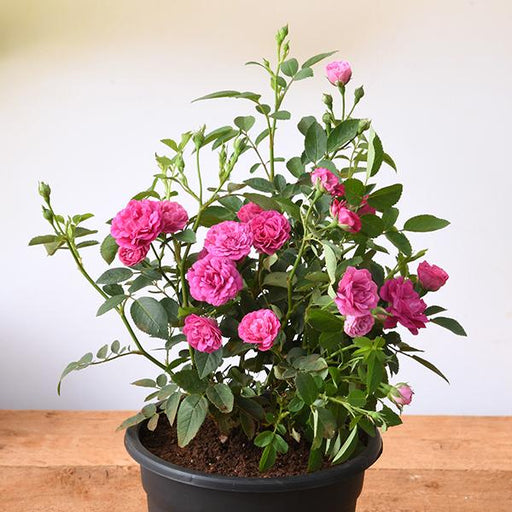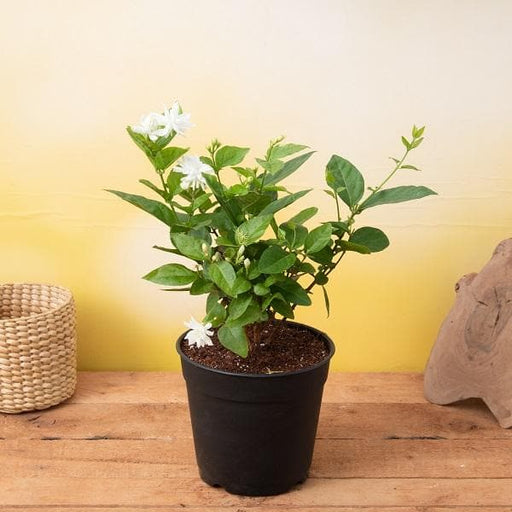
Annona atemoya, Lakshmana phal ( Grown through seeds ) - Plant
(MRP Inclusive of all taxes)
- Shipping ₹79 for entire order
- Dispatch in 7 days
- Country of origin: India

(MRP Inclusive of all taxes)
 Save 29%
Save 29%
Air Purifier Money Plant with Pot The Air Purifier Money Plant, also known as Pothos or Epipremnum aureum, is a stunning indoor plant that...
View full details
 Save up to 15%
Save up to 15%
Peace Lily, Spathiphyllum - Plant The Peace Lily, scientifically known as Spathiphyllum, is a stunning houseplant celebrated for its elegant white...
View full details
 Save 25%
Save 25%
Jasminum sambac, Mogra, Arabian Jasmine - Plant Jasminum sambac, commonly known as Mogra or Arabian Jasmine, is a fragrant flowering plant...
View full details
 Save 18%
Save 18%
Combo Constituents Includes the Parijat Tree (Night-Flowering Jasmine), a culturally significant plant with fragrant flowers. Description The Pari...
View full details
 Save 25%
Save 25%
Miniature Rose, Button Rose (Any Color) - Plant The Miniature Rose, also known as the Button Rose, is a charming and compact flowering plant that ...
View full details Save 25%
Save 25%
Damascus Rose, Scented Rose (Any Color) - Plant The Damascus Rose, also known as Rosa damascena, is a timeless symbol of beauty and romanc...
View full details
 Save 17%
Save 17%
Beautiful Fragrant Mogra, Arabian Jasmine Plant with Pot The Beautiful Fragrant Mogra, also known as Arabian Jasmine (Jasminum sambac), is...
View full details Save 15%
Save 15%
Pack of Vermicompost and Neem Cake for House Plants Transform your indoor garden with our premium Pack of Vermicompost and Neem Cake, spec...
View full details
Pack of Plant Growth and Flower Boosters Unlock the full potential of your garden with our Pack of Plant Growth and Flower Boosters! This ...
View full details Save 38%
Save 38%
Combo of Jeevamrut and Neem Raksha for Easy Growth and Protection of Houseplants Transform your indoor garden with our exclusive combo of ...
View full details Save 22%
Save 22%
Plant Nutrients Kit (Pack of 16) for a Healthy Garden Transform your garden into a lush paradise with our Plant Nutrients Kit, featuring 1...
View full details Save 16%
Save 16%
Combo of Top Plant Fertilizers Elevate your gardening game with our exclusive Combo of Top Plant Fertilizers, featuring two bags of premiu...
View full details Save 24%
Save 24%
Pack of 4 Additives to Make Soil Healthy and Nutrient Rich Transform your garden into a thriving ecosystem with our Pack of 4 Additives de...
View full details Save 30%
Save 30%
Transform your gardening experience with our premium Combo of Perlite and Vermiculite. This unique blend is designed to enhance soil aeration and ...
View full details Save 27%
Save 27%
Combo of 2 Vermicompost and Cocopeat - Enrich Your Soil Naturally! Transform your garden into a thriving ecosystem with our Combo of 2 Ver...
View full details
 Save 35%
Save 35%
Best 6 Plants for Perfect Indoor Garden Transform your living space into a lush oasis with our curated collection of the Best 6 Plants for a...
View full details
 Save up to 50%
Save up to 50%
Mini Succulent Garden Pack Transform your space with our Mini Succulent Garden Pack, featuring a delightful collection of 4 any variety beautiful s...
View full details
 Save 30%
Save 30%
5 Best Fragrant Plants Transform your garden or indoor space into a fragrant paradise with our curated selection of the 5 Best Fragrant Plants. Th...
View full details
 Save 24%
Save 24%
Set of 2 Bonsai Looking Grafted Adeniums Transform your indoor or outdoor space with our exquisite Set of 2 Bonsai Looking Grafted Adenium...
View full details Save 45%
Save 45%
Top 4 Die Hard Succulents Pack Transform your indoor or outdoor space with our Top 4 Die Hard Succulents Pack, featuring a curated selecti...
View full details
 Save 30%
Save 30%
5 Best Indoor Plants Pack Transform your living space into a lush oasis with our '5 Best Indoor Plants Pack.' This carefully curated collection fe...
View full details
 Save 25%
Save 25%
Set of 4 Evergreen Air Purifier Plant Pack Transform your indoor space into a lush, green oasis with our Set of 4 Evergreen Air Purifier Pla...
View full details| SrNo | Item Name | Qty |
|---|---|---|
| 2 | Annona atemoya, Lakshmana phal ( Grown through seeds ) Plant | 1 |
The Annona atemoya, commonly known as Lakshmana Phal, is a tropical fruit tree renowned for its sweet, creamy, and custard-like fruit. This unique plant is a hybrid of the cherimoya and the sugar apple, offering a delightful taste that is both exotic and refreshing. Grown from seeds, this plant is perfect for home gardeners looking to cultivate a piece of tropical paradise in their own backyard.
What makes the Annona atemoya special is its rich nutritional profile, packed with vitamins A and C, fiber, and antioxidants. This fruit not only tantalizes the taste buds but also supports overall health. Its unique flavor profile and creamy texture make it a favorite among fruit enthusiasts and chefs alike.
One of the standout features of the Lakshmana Phal is its adaptability to various climates, thriving in subtropical and tropical regions. With proper care, this plant can yield fruit within 2-3 years of planting, making it a rewarding addition to any garden.
Growing Annona atemoya contributes positively to the environment by promoting biodiversity and providing habitat for various pollinators. Additionally, its cultivation can help improve soil health and reduce carbon footprints when grown sustainably.
This tropical delight, also known as the cherimoya's cousin, is a fruit that’s as exotic as it sounds. With a creamy texture and a flavor reminiscent of a sweet blend of banana, pineapple, and vanilla, it’s a taste bud party waiting to happen. Growing this beauty from seeds is like playing horticultural roulette—will you get a fruit-bearing tree or a leafy green friend? Either way, you’re in for a treat!
The Lakshmana phal, or the “fruit of Lakshmana,” is not just a name; it’s a legend! This fruit is steeped in mythology and is said to have healing properties. When you grow it from seeds, you’re not just planting a tree; you’re cultivating a piece of history. Plus, who wouldn’t want to impress their friends with a fruit that sounds like it belongs in an epic tale?
Ah, seed propagation—the art of turning tiny specks into towering trees! It’s like magic, but with dirt and patience. When you grow Annona atemoya from seeds, you’re engaging in a delightful dance of nature. Just remember, it’s not a race; good things come to those who wait (and water).
If you’re dreaming of a backyard oasis, tropical fruit trees are your ticket to paradise. Annona atemoya is the star of the show, but don’t forget about its fruity friends! Imagine plucking fresh mangoes, papayas, and, of course, your very own Lakshmana phal. It’s like having a mini tropical vacation right outside your door.
To grow Annona atemoya successfully, you need to channel your inner Goldilocks—finding the perfect conditions is key! This plant loves warm, sunny spots with well-draining soil. Too much shade? It’ll sulk. Too much water? It’ll throw a tantrum. Just right, and you’ll be rewarded with luscious fruits that’ll make your neighbors green with envy.
Caring for your Annona atemoya is like nurturing a diva. It requires attention, love, and the right nutrients. Regular watering, occasional pruning, and a sprinkle of fertilizer will keep your tree happy and productive. Remember, a well-cared-for tree is a fruitful tree, and who doesn’t want to be the talk of the town with their homegrown treasures?
Harvesting Annona atemoya is an art form. You want to wait until the fruit is slightly soft to the touch, like a ripe avocado, but not too soft—nobody likes mushy fruit! Gently twist and pull, and voilà! You’ve got yourself a delicious treat. Just be prepared for the inevitable “where did you get this?” questions from your friends.
Annona atemoya isn’t just a pretty face; it’s packed with nutritional goodness! Rich in vitamins C and B6, fiber, and antioxidants, this fruit is a health powerhouse. Eating it is like giving your body a high-five. Plus, it’s low in calories, so you can indulge without the guilt. Who knew being healthy could taste so good?
Every gardener’s nightmare—pests! But fear not, for managing pests on your Annona atemoya can be a fun challenge. From aphids to fruit flies, a little vigilance goes a long way. Natural remedies like neem oil or introducing beneficial insects can keep your tree thriving. After all, a healthy tree is a happy tree, and happy trees bear fruit!
The culinary possibilities with Annona atemoya are endless! From smoothies to desserts, this fruit can elevate any dish. Imagine a creamy atemoya ice cream or a tropical fruit salad that steals the show. Your kitchen will become the talk of the town, and your friends will be begging for your secret recipes. Who knew being a fruit aficionado could be so deliciously rewarding?
Growing Annona atemoya from seeds is not just a hobby; it’s a step towards sustainability! By cultivating your own fruit, you’re reducing your carbon footprint and embracing a more eco-friendly lifestyle. Plus, you’ll be contributing to biodiversity, which is like giving Mother Nature a high-five. So, plant those seeds and watch your green thumb work its magic!
Annona atemoya, or Lakshmana phal, is a tropical fruit that’s a delightful hybrid of cherimoya and sugar apple. It’s like the love child of two fruits, boasting a creamy texture and sweet flavor that can make your taste buds dance. Perfect for those who enjoy a fruity fiesta!
Growing Annona atemoya from seeds is like starting a fruity adventure! First, soak the seeds overnight, then plant them in well-draining soil. Keep them warm and moist, and soon you’ll have a mini jungle of potential deliciousness sprouting in your garden. Just remember, patience is key—good things take time!
Lakshmana phal loves a warm hug from the sun! Aim for well-draining soil, plenty of sunlight, and a cozy temperature between 65°F to 85°F. It’s like a tropical vacation for your plant! Just avoid frost, as it’s not a fan of chilly weather—who is, really
Patience, my friend! Annona atemoya seeds typically take about 2 to 4 weeks to germinate. It’s like waiting for a surprise party—exciting but requires some time. Keep the soil moist and warm, and soon you’ll see those little green warriors breaking through the surface!
After planting, expect your Lakshmana phal to start bearing fruit in about 3 to 4 years. It’s like waiting for a fine wine to age—worth the wait! Once it starts producing, you’ll be rewarded with a bounty of sweet, creamy fruits that’ll make your garden the talk of the town.
Caring for your Annona atemoya is like nurturing a diva! Provide regular watering, but don’t drown it—drainage is key. Fertilize during the growing season and prune as needed. Keep an eye out for pests; they can be party crashers. With love and attention, your plant will thrive!
Your Lakshmana phal might attract some uninvited guests like aphids, mealybugs, and fruit flies. Think of them as the annoying relatives of the plant world. Regularly inspect your plant and use organic insecticides or neem oil to keep these pests at bay. A little vigilance goes a long way!
Absolutely! Growing Annona atemoya in a pot is like giving it a luxury apartment. Choose a large container with good drainage, and ensure it gets plenty of sunlight. Just remember to water it regularly and provide nutrients. Your potted plant will thrive and may even become the envy of your neighbors!
Yes, Annona atemoya is a self-pollinating superstar! It can produce fruit without needing a partner, making it the ultimate independent plant. However, having multiple plants can increase fruit yield, so consider inviting a few friends to the party. More plants, more fun, and more delicious fruits!
Lakshmana phal is like a tropical dessert in fruit form! Its creamy, custard-like flesh is sweet with hints of banana and pineapple. Imagine indulging in a fruity ice cream without the guilt! It’s a treat that can make any fruit lover swoon and dream of sunny beaches.
Harvesting Annona atemoya is like picking ripe treasures! Wait until the fruit is slightly soft to the touch and has a sweet aroma. Gently twist or cut it from the branch—no need to wrestle! Enjoy your bounty fresh or use it in smoothies, desserts, or just as a snack.